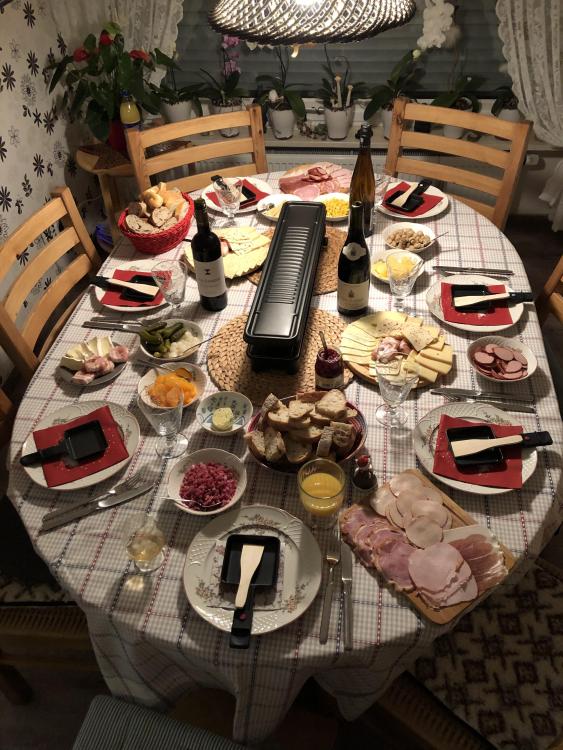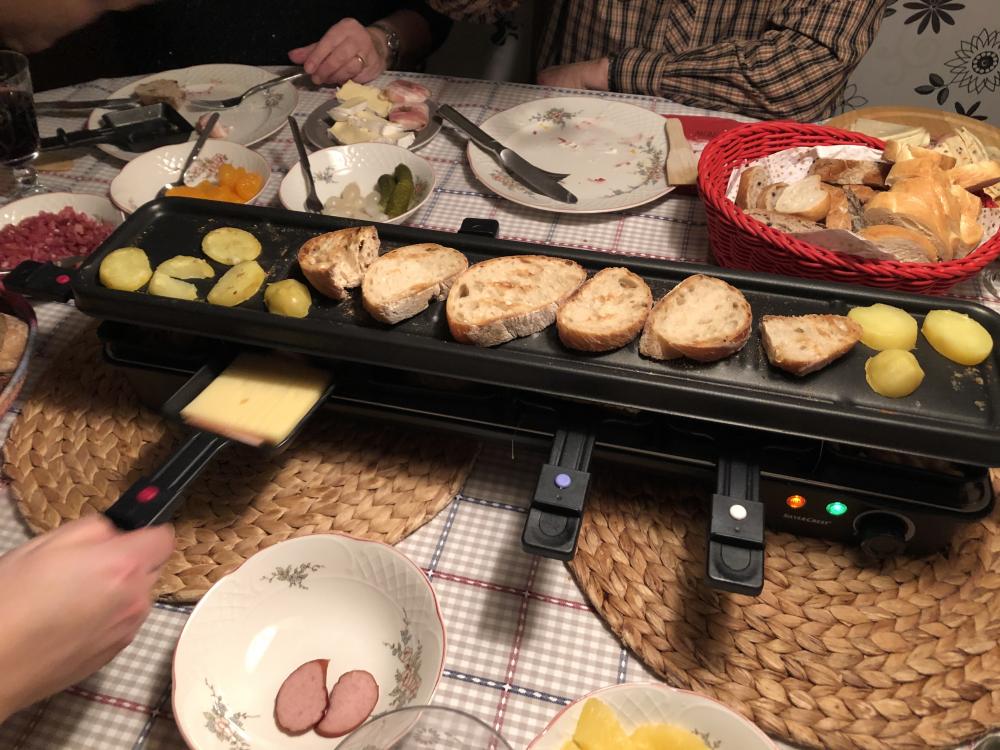-
Posts
4,233 -
Joined
-
Last visited
Content Type
Profiles
Forums
Store
Help Articles
Posts posted by Duvel
-
-
1 hour ago, Ann_T said:
Made dinner for breakfast again this morning.
I admire Moe‘s (and yours) dedication to go to work after that. I would probably get a whiskey highball, enjoy and call it a day 😉-
 5
5
-
-
Use it.
Firstly, a blackened pancake is not a good temperature indicator.
Then, perfluorinated polymers are very sturdy and do not really undergo many decomposition reactions at higher temperatures, but rather start to depolymerise at 600 oC+. This you would have noticed 😉 ...
Lastly, only at prolonged heating above 250 oC you could see some “creeping” in the polymer and thinning out the polymer layer, if you had some heavy stuff in your pan. Again, that blackened pancake won’t qualify.So, I’d continue to use it.
-
19 minutes ago, kayb said:
3. Ro-Tel dip (100 percent Velveeta)
I had to google that. I have never heard of Ro-Tel before, nor have I ever had a product based on that description. It sounds good though, and that dip must be delicious ...-
 2
2
-
-
@Kim Shook: One (German) word: Fantastisch !
-
 3
3
-
-
There would be three steps that could help you, if you do not want to spend an extra day drying the surface in the fridge:
1) scoring the skin after SV (smaller squares preferred) to help the rendered fat “escape” the skin.
2) Brush with saltwater to help drawing surface moisture out during the crisping up.3) Heat with a broiler at full whack, but plenty of space to your roast. The infrared will heat through the skin layer, render the fat and pop up the skin. It will take 10~15 min, so some distance is required. Heat carryover into the meat is minimal.
Hope this helps (next time) ...
-
 1
1
-
 2
2
-
-
15 minutes ago, Susanwusan said:
Hi. I want to make a beef in beer pie - what sort of beer would work best, that would be available from an English supermarket.
It depends a bit on your preferences, but in general a full-bodied and only lightly hopped beer would be a good choice. So, a brown ale would do fine - Newcastle brown ale is available near you ?-
 1
1
-
-
On 12/27/2020 at 3:00 PM, Ann_T said:
Moe wanted leftover tourtiere for breakfast.
Who wouldn’t ? Seriously - gorgeous dish !-
 2
2
-
-
20 minutes ago, weinoo said:
For this dish, I do cook the Setaro spaghetti in less water than nonna might normally use,
You monster !!!-
 4
4
-
-
@Kim Shook Even without the crackling it looks very yummy - so juicy !
Did you insert any drying step (e.g. fridge rest, salt, ...) before roasting ? And how did you apply the heat ?
-
15 minutes ago, weinoo said:
Worked pretty fine. I don't know how or what technique they used to keep it from turning into a sticky mess; I'll ask them next time I see them. It must be what they do regularly since I know they're not making spaetzle a la minute when it's ordered regularly.
Cooked Spätzle are easily reheated in hot butter (with aromatics, such as caramelised onions, if desired). If they are cooked and cooled they tend to coagulate due to residual starch, but once warmed in the butter they break up easily. I have never seen them sintering into a mess.That being said, you can easily taste the difference (and I don’t mean to say that reheated is inferior - they are a different dish), so if I would order Spätzle as a side dish in a restaurant and they are not prepared a la minute (and they literally take a minute to cook), I would heavily complain ...
-
 1
1
-
-
28 minutes ago, Katie Meadow said:
Step 1: get a three-legged stool.
Step 2: put on goggles.
And then?
SQEEEEEEEZE !-
 2
2
-
 4
4
-
-
12 minutes ago, weinoo said:
What's onion milk?
Never milked an onion ?!
-
 2
2
-
-
-
-
11 hours ago, weinoo said:
These look practically like my grandmother's - though she probably didn't have any nonstick.
Same visuals in my memory. My grandma used a blue enameled frying pan with a cracked wooden handle. Definitely not designed nonstick, but as her potato pancakes were exclusively fried swimming in lard and that specific pan was only used for frying potato pancakes I assume that ~40 years plus of usage left the surface as nonstick as any perfluorated polymer 😉-
 4
4
-
-
45 minutes ago, liuzhou said:
That ain't gonna happen. I may have low standards, but I have standards.
Yes, but you are also well known to be a people pleaser, so I will continue to try ... 😜-
 1
1
-
 3
3
-
-
12 hours ago, liuzhou said:
But I have never been inside a McDonald's and I am certainly not a member.
Sorry, with the travel ban and all there is no way I make it in time. So we need to count on you to take one for the team. McD in China delivers, as far as I remember - so no need to step into the lion’s den 👍
So please just get that burger and give us an unbiased review (unlike that fake news outlet, that even US presidents disapprove of ...).
-
 1
1
-
-
1 hour ago, weinoo said:16 hours ago, Duvel said:Expand
I usually buy Hinode. It is one of the more economic brands and I used to buy it when I was living in Japan, so I kept the habit. I have another (more fancy) one down in my cellar which came in a care package from a dear Japanese friend, but I haven’t gotten to try it yet.
I actually did a little more research, and it sure appears as if one of, if not the main reason that salt appears in that Ohsawa Mirin, as well as in the Eden Foods brands mirin imported from Japan (which is also highly touted and which I also bought) has to do with changing it from an alcoholic beverage (i.e. wine) into a cooking product (i.e. cooking wine).
Or, you could have just read my post ... 😉16 hours ago, Duvel said:And that being said: shio-mirin is a product of its own right (though often used to circumvent the import tax for alcoholic beverages),
But this is usually not the major difference. Typically, the shio-mirin has little to no alcohol, as opposed to say 14% in hon-mirin. Please check the label on the Ohsawa.
To illustrate the difference: If your recipe calls for an off-dry Riesling you could use off-dry Riesling (equivalent to a hon-mirin) or substitute grape juice with added salt (your shio-mirin). You can get great flavour profile from a nice grape juice, organic and all and the best sea salt there is, but at the end it won’t give you the result from the off-dry Riesling. If you notice and/or accept the difference depends on you and your point of reference. -
I usually buy Hinode. It is one of the more economic brands and I used to buy it when I was living in Japan, so I kept the habit. I have another (more fancy) one down in my cellar which came in a care package from a dear Japanese friend, but I haven’t gotten to try it yet.
-
 1
1
-
-
3 minutes ago, weinoo said:
Thanks - I do not know him. It could be that Japanese cuisine is not one of his areas of full expertise. He certainly might be right that his favored product could have a deeper & more complex flavor than (at least the available) Kikkoman choices in the US.And that being said: shio-mirin is a product of its own right (though often used to circumvent the import tax for alcoholic beverages), and the one you‘ve chosen seemingly comes from a reputable producer - so please enjoy !
-
 2
2
-
-
The bottle on the left is aji-mirin (as you know) and should be quite sweet. This is what you want to use if your recipe asks for mirin.
The bottle on the right is ryorishu or cooking sake. It should not be sweet at all and you can use it if a recipe calls for sake.
-
 1
1
-
 1
1
-
-
7 minutes ago, ElsieD said:
So I have these two bottles. One is sweet, the other is not. What is the one on the right, then? I thought it was unsweetened mirin.
Mirin should always be sweet (either by natural fermentation or added sugars). Do you have a picture ? -
23 minutes ago, weinoo said:
We should all know Kimball is a liar...
I have no idea who Kimball is. -
5 minutes ago, ElsieD said:
Can someone please tell me when a recipe calls for mirin, and mirin is all it says, is it calling for the sweetened stuff or the unsweetened?
Actually, all mirin is sweet. It is similar to a sweet sake, where part of the starches have been converted into sugars. This can happen naturally (and the sugars undergo subsequent alcoholic fermentation) to produce hon-mirin.You can cut the process short, add alcohol and sugars (HFCS if you are unlucky), and get aji-mirin or mirin-fu, which tastes very “one-dimensional”, yet has the sweetness of regular mirin.
So you can use any mirin type in cooking in light of the sweetness, adjusting a bit for your taste, of course...
-
 1
1
-







Dinner 2020
in Cooking
Posted
Tonight’s dinner started actually at tomorrow’s dinner: I started to make Chikuwa - Japanese fishcakes - and deviated from my usual recipe by using previously frozen fish. It should have been clear to me that this wouldn’t work, but ...
Like my professor used to say: You don’t have time to do it proper, but obviously you always have time to do it again 😶
I decided to call it a day and make some take-out style “Chinese” fried noodles. Topped with Laoganma chili crisp. Foolproof. And accompanied by a (tiny bit strong) highball ...
All good. And when the family asked for “what’s next” I used the quart of hot oil to make some Taiwanese Night Market pork. A pound of pork neck disappeared faster than it was cooked (or photographed). Quality save 🥳